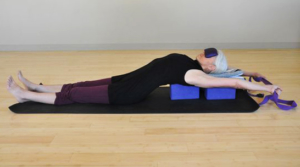 When we use the term “open-hearted” what comes to mind is a person whose kindness extends to all. We can develop an open heart by practicing qualities such as those listed in the yoga sutras. These include kindness, compassion, empathetic joy and equanimity.
When we use the term “open-hearted” what comes to mind is a person whose kindness extends to all. We can develop an open heart by practicing qualities such as those listed in the yoga sutras. These include kindness, compassion, empathetic joy and equanimity.
We can also open our physical heart space in our asana practice. Practicing poses that mobilize and expand the rib cage help us maintain mobility and spaciousness in that area. The rib cage is the structure that houses the heart. Mobilizing the thoracic spine, to which the ribs are attached, is the most effective way to create spaciousness for the heart.
February is Heart Health Month. Deep, abdominal breathing—as opposed to shallow, upper chest breathing—is essential to maintaining heart health. In Donna Farhi’s The Breathing Book, she explains the relationship between breathing and heart health:
“There have been a number of significant studies showing a correlation between upper chest breathing and heart disease. In one stunning report, patients who had already experienced a heart attack were taught how to breathe diaphragmatically and to generalize this behavior in everyday activities. In doing so they significantly reduced their chances of having a second heart attack.”
Deep, diaphragmatic breathing depends on chest and abdominal mobility. In honor of Heart Health Month, we’ll explore a three poses that expand and mobilize the rib cage and abdomen to promote free breathing and open-heartedness.
Expand the Heart
There are many, many poses in asana practice that can mobilize the rib cage. The three below can stand for other poses in their class—lateral bending, twisting and back bending. I’ve chosen relatively simple practices because part of expanding the heart is being kind to your body.
For the first two poses, you’ll just need a nonskid mat. For the third one (pictured at the top of this article), gather a couple of yoga blocks and one or more blankets.
- Talasana (Palm Tree Pose): Mobilizing the rib cage requires that we mobilize the thoracic spine. The thoracic spine is built for lateral bending. In addition, when we bend to the side, we stretch the soft tissue and create space between the ribs on the opposite side. Since the lungs are also housed in the rib cage, there’s more room to breathe. Here’s a post explaining how to practice Talasana.
- Jathara Parivartanasana (Revolved Belly Pose): In addition to lateral bending, the thoracic spine is built for rotation. Any twist will help mobilize that section of the spine. There are, of course, lots of wonderful standing and seated twists. But lying down creates a different relationship to gravity, one that allows for easier breathing, and therefore, more mobility. Here’s a post that explains the how-to of this pose.
- Matsyasana (Supported Fish Pose): Once you’ve mobilized your thoracic spine in the ways it’s designed to move, you can challenge it with a back bend. The thoracic spine doesn’t actually extend much. The facet joints, the joints between each vertebrae, are designed to put brakes on back bending. But that doesn’t mean that you can’t still extend the thoracic spine a bit. Because we all spend so much time hovering over desks, steering wheels and the like, it wouldn’t be a bad idea to practice this pose every day. Here’s a description of how to practice. One suggestion: In order for this pose to be comfortable, your head needs to be level, not tilting back. Make sure to put enough blankets under your head and neck to ensure that your neck is relaxed. Then relax and enjoy!
You can practice these three poses on their own, or you can practice them to prepare for more challenging back bending poses. Make sure you breathe deeply and continuously throughout your practice.
